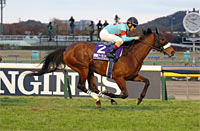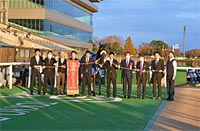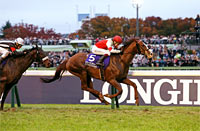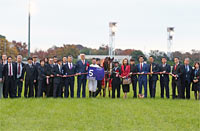Japan Cup (G1) - Comments from Japanese runners' connections

Biche Yuichi Shikato, trainer
“She was in good shape for the Shuka Sho and the trip to the track didn’t seem to be a problem. But to have gotten the poor results she did, I can’t figure out what the problem was. Perhaps it’s hard for fillies when they draw wide in a Kyoto 2,000 meter race this time of the year. It was a slow pace and she was forced to run wide so maybe she just didn’t have enough left in the end. We sent her to the farm for a bit after that as usual and had her checked over before deciding to race her here. She came back to the training center on Nov. 11 and we worked her up the hill course on Nov. 13. On Nov. 16, she worked on the woodchip course and looked fine. I think she’ll head into the race in good shape. This time, she’ll be up against top-level male horses as well, so I can’t make any claims. Still, she has always been suited to Tokyo and has no problems over 2,400 meters. She’ll also be carrying only 53 kg, so I’m hoping she’ll show us some good stuff.”
|
|

Cheval Grand
Cheval Grand (colt, 3)
Yasuo Tomomichi, trainer
“Even towards the end of August, he still wasn’t fully recovered from the Takarazuka Kinen, so I decided to pass on the Kyoto Daishoten. Still, he had had ample work and went into the Copa Republica Argentina in good shape. And on top of that, he had no issues with his first trip to eastern Japan and his first time racing to the left. Going to the Japan Cup was something I had planned on all along. He came out of his last race looking good and we started him back in training the Thursday of the week following that race. His fast work on Nov. 16 was about 89 seconds over 6 furlongs with no pressure whatsoever and that’s sufficient. This week the jockey rode him on Nov. 23 but didn’t push him this time either. He’ll go into the race having maintained his condition well. I think he was tired for the Takarazuka Kinen. I think if he’d been ridden a bit more forward in the Tenno Sho (Spring), he’d have done even better. He has gotten a lot stronger. It’s a strong lineup but I’m looking forward to the long Tokyo stretch.” |
|

Dee Majesty
Dee Majesty (colt, 3)
Akio Shimada, groom
“Looking at the results in the Kikuka Sho (Japanese St. Leger), I’d have to say that maybe he was a bit heavy. That and the fact that he hit his hoof badly during the race. It was an unfortunate run. The most important thing is that nothing bad came of it. Looking at his condition, the owner and trainer discussed it and decided to race him in the Japan Cup. (Jockey) Masayoshi Ebina rode him in work on Nov. 16 and he had a 5-furlong workout for the second week in a row. Things have gone well in his training and on Nov. 17 he weighed in at 481 kg. It should be good if he can be around 480 kg for the race. He’s 3 years old so he’ll have a weight advantage over the older horses. I’ll be happy if he can rally at the same venue where he lost the Japanese Derby, but I really just want him to do his best.” |
|

Fame Game Yoshitada Munakata, trainer
“I think having been gelded before the last race had positive effects. He no longer has his quirks and he’s much easier to control. The jockey had wanted to ride him a bit more forward but the pace was slow and only after it picked up did he quicken well. We took him to the farm after that, then back to the training center on Nov. 16. We haven’t let him slack off and there has only been a little time between races so two fast gallops at Miho were sufficient. He’ll need a little more time since being gelded to be back at his best though, so he’s still improving. And the competition will be stronger. But the venue is a good one for this horse.” |
|

Gold Actor
Gold Actor (horse, 5)
Tadashige Nakagawa, trainer
“His win of the Sankei Sho All Comers was a win that came after a layoff just as he was improving. It was an ideal return to the track. With that race, he has toned up nicely. It has stoked his metabolism and you can see the very visible difference in the improved sheen on his coat. His time in work on Nov. 16 was sufficient, but I did think he looked a bit heavy on his feet, a bit lethargic. But this has made the final tuneup this week that much easier and we’ll be able to have him in tiptop shape for the race. He’s maturing in many ways but his ability to settle so much better now is a big thing. That, and he’s physically much stronger now. There’s tough competition in the lineup but this horse is very competitive and I want him to show us that this time out. My expectations for a good race are high.”
|
|

Hit the Target Keiji Kato, trainer
“He had a ground-saving run in the Kyoto Daishoten and he ran well for him in the stretch. But the pace was slow and the frontrunners held their ground. He did the best that he could. Training has gone as usual since then and his movement in work on Nov. 16 looked good. He is his usual self. The Tokyo course is fine for him but he does need to have it just right with a lot of things. One thing is wanting to have an inside run on the rail and if the ground is bad, he won’t want to run. A good track is a must. He has done well in a Grade 1 before, but he can’t run well at length. It’ll be hard for him but if he gets the kind of race he prefers, we’ll see how well he can do.”
|
|

Kitasan Black
Kitasan Black (colt, 4)
Hisashi Shimizu, trainer
“He’d been racing in the lead a lot recently, so I was hoping he would not get upset, and as I had hoped, the jockey held him back very gently, very carefully and did a real good job of keeping him calm. It was a much stronger win than his winning margin of a neck would indicate and a very good start to his fall campaign. His fast work last week was the usual, running in tandem with him catching and passing the other horse. I haven’t changed his training at all. I just regulate the intensity of it. And in his latest fast work, when he passed the other horse, he didn’t start to flounder out there on his own, but continued to run well. He clocked 79.5 seconds and I think he understands that he has to move. Physically, he is getting more and more into racing shape. If things go as they have been, we’ll be able to pass the baton to the jockey on raceday and see him off in fine shape. He’s fine with the trip to the track and the distance and he can handle any way the race unfolds. I have no matters of concern. It’s the same stage as the Tokyo Yushun (Japanese Derby), which he did so poorly in, and I want him to banish any bad memories he may have of the Tokyo turf race over 2,400 meters.”
|
|

Last Impact Norihiko Kishimoto, assistant trainer
“He traveled nicely in the Kyoto Daishoten and had a smooth trip but the slow pace, which brought it all down to a final battle of late speed was too tough for him. If you have to say either way, he’s the kind that can run at length at a steady pace and does best with a race that calls for stamina. I think the race just didn’t suit him. We gave him time off at the farm and then aimed him here, calculating back from raceday to the day we brought him back to the training center. Since he returned, he’s been getting regular work as planned. The jockey took him over the course last week and the horse took the bit in his teeth a bit and didn’t have enough left for the finish. But I think he’s in good shape. This week we gave him a hard run up the hill on Nov. 23. Looking at what he’s done up to now, I’d say racing to the left will be good for him. He was second here last year and I’m hoping for good results.” |
|

One and Only Shinsuke Hashiguchi, trainer
“In his last start, I’d wanted the jockey to move him out early but with the slow pace he wasn’t able to do that. He showed some nice speed in the stretch but the frontrunners weren’t easy to catch, and he gave his everything to get where he did. Recently, he’s been struggling to pick up pace from the third corner to the final turn, and I’d been trying ways to help that in training. I think that training helped him in the last race, as he wasn’t left behind coming into the homestretch, and the quality of his racing has improved overall. When there are just two full weeks in between races, I like to clock him on Sunday but I wanted to push him hard the week before race week. So, this time we did that on Nov. 18 and I think we’ll see good results. If the pace is slow, it makes it difficult for him, so I’m hoping for a good pace. With the horses from overseas participating, I think the pace will be stronger than usual and I think he should be able to do better.”
|
|

Rainbow Line Keiichi Asami, assistant trainer
“In the Kikuka Sho (Japanese St. Leger), he was looking pretty keen there for a while and somehow, despite that, the jockey was able to do a good job with the ride. It was quite a feat that he did so well until the very end. He came back to the training center on Nov. 15 and everything looked to be in order. He’d gotten a lot of riding work at the farm and he’s the kind of colt that doesn’t need us to do so much to get him ready. He’s been doing well like that up until now so I don’t see any problems. In the Japanese Derby, he was pretty agitated even before he went out on the track. We’ll be more careful to try to keep him calm this time and just how well we can succeed will be key, but it will be his third trip to Tokyo, so he should be somewhat used to things. The shorter distance will be a plus. We raced him in the Sapporo Kinen and the experience racing against older horses, including Maurice, was a great experience for him. I think he’s a lot stronger than he was in the spring and he should be able to do well if he can settle nicely into the pace.”
|
|

Real Steell
Real Steel (colt, 4)
Yoshito Yahagi, trainer
“In the Tenno Sho (Autumn), he settled well even with that slow pace and the wide draw. He still hadn’t been himself before that, so it was good we decided not to go to the Mainichi Okan. In the Tenno Sho (Autumn), he was able to show us some very good racing. I don’t see any visible differences in him but he has come along as I had imagined he would and I think there will be improvement. Like before his last race, we went easy this week, but last week we pushed him hard. He tried much harder than I thought he would and even though he couldn’t catch the horse we put in front of him, his time was convincing. He was only at about 80-85 percent for the Tenno Sho (Autumn) but this time there’s more on the line and we’re more concerned about winning. I think his best distance is 2,000 meters, but he really did settle well last out, so I’m leaving the final 400 meters up to the skill of an ace jockey.”
|
|

Rouge Buck Masahiro Otake, trainer
“In the Tenno Sho (Autumn), she got pushed toward the rail in the stretch and it was a difficult race. And at that point her responses were poor and the horses in front widened the gap, which hurt too. In the end she did fight back and if the race had been a smoother one, she would have gotten even further. But she was in good shape and for her responses to be a bit off was probably due to it being the first time the rotation was tighter than usual. She wasn’t able to go all out so even right after the race she wasn’t out of breath and she didn’t look tired. As always, we gave her a bit of time off and on Nov. 9 and Nov. 14 they worked her up the hill at the training farm. She came back to Miho Training Center on Nov. 16 and I didn’t see anything to worry about regarding her condition. She had a good run in the Yushun Himba (Japanese Oaks) but that was running against other fillies of the same age. She ran 10th in the Arima Kinen (The Grand Prix), so we’ll just have to see how well she can do here.” |
|

Sounds of Earth (Yello cap) Kenichi Fujioka, trainer
“The Kyoto Daishoten was his first race after a layoff and I think he showed good speed in the final stages. The horse expected to lead the race didn’t set as fast a pace as expected and so with the slower pace it made things difficult in the end. After that race, we’ve trained him with this race alone as our target. He was a bit faster than we’d wanted on Nov. 9 but his movement was good. Last week we pushed him hard and even though he was a bit slow in the first half, he ran the last furlong in the 11 second range. I think he’s improved. He always looks good in the autumn. This week he worked in tandem over distance with a focus on the final lap, which is just right since he has the long trip to the track ahead of him. Last year, despite interference, he still didn’t finish that far off of the winner, which was really frustrating. He’s suited to 2,400 meters. I think if he can use his late speed like he did last race over the wide-open Tokyo course, he’ll give us a good race. I so want him to win a big race.”
|
|
| Tosen Basil (colt, 4)
Nobuyuki Tashiro, assistant trainer
“The pace was slow in the October Stakes but he settled well, then really moved to cover the last 3 furlongs in 33.1 seconds. I think he was stronger than his winning margin would indicate. After that race, we gave him a bit of time off at the farm before bringing him back and heading him for this race. We worked him with two other horses on Nov. 17 over the woodchip course for 6 furlongs and then this week over 5 furlongs. We pushed him pretty hard last week so went easy this week. There’s a bit of time between races but he can move well. Recently, he is able to concentrate in the race and he’s put on muscle on his hindquarters. He is 3-for-3 on a left-handed course and the spacious track suits him. The competition will suddenly become much stronger but I think he’ll be able to hold his own.”
|
Sources: Keiba Book, netkeiba
|

- Preview
- Barrier draw
- Past performances of runners

- News
- Race result
- Video
- 2020 English

- 2019 English

- 2018 English

- 2017 English

- 2016 English

- 2015 English

- 2014 English

- 2013 English

- Photo Gallery
2020 Winner: Almond Eye



2019 Winner: Suave Richard


|





